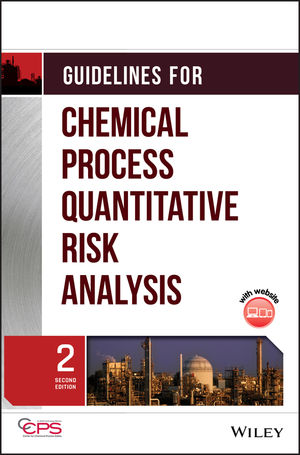Guidelines for Chemical Process Quantitative Risk Analysis, 2nd EditionISBN: 978-0-8169-0720-5
Hardcover
784 pages
October 1999
 This is a Print-on-Demand title. It will be printed specifically to fill your order. Please allow an additional 10-15 days delivery time. The book is not returnable.
|
||||||
Preface to the First Edition.
Acknowledgments.
Acknowledgments to the First Edition.
Management Overview.
Organization of the Guidelines.
Acronyms.
1. CHEMICAL PROCESS QUANTITATIVE RISK ANALYSIS.
1.1 CPQRA Definitions.
1.2 Component Techniques of CPQRA.
1.2.1 Complete CPQRA Procedure.
1.2.2 Prioritized CPQRA Procedure.
1.3 Scope of CPQRA Studies.
1.3.1 The Study Case.
1.3.2 Typical Goals of CPQRAs.
1.4 Management of Incident Lists.
1.4.1 Enumeration.
1.4.2 Selection.
1.4.3 Tracking.
1.5 Applications of CPQRA.
1.5.1 Screening Techniques.
1.5.2 Applications within Existing Facilities.
1.5.3 Applications within New Projects.
1.6 Limitations of CPQRA.
1.7 Current Practices.
1.8 Utilization of CPQRA Results.
1.9 Project Management.
1.91. Study Goals.
1.9.2 Study Objectives.
1.9.3 Depth of Study.
1.9.4 Special User Requirements.
1.9.5 Construction of a Project Plan.
1.9.6 Project Execution.
1.10 Maintenance of Study Results.
1.11 References.
2. CONSEQUENCE ANALYSIS.
2.1 Source Models.
2.1.1 Discharge Rate Models.
2.1.2 Flash and Evaporation.
2.1.3 Dispersion Models.
2.2 Explosions and Fires.
2.2.1 Vapor Cloud Explosions (VCE).
2.2.2 Flash Fires.
2.2.3 Physical Explosion.
2.2.4 BLEVE and Fireball.
2.2.5 Confined Explosions.
2.2.6 Pool Fries.
2.2.7 Jet Fires.
2.3 Effect Models.
2.3.1 Toxic Gas Effects.
2.3.2 Thermal Effects.
2.3.3 Explosion Effects.
2.4 Evasive Actions.
2.4.1 Background.
2.4.2 Description.
2.4.3 Example Problem.
2.4.4 Discussion.
2.5 Modeling Systems.
2.6 References.
3. EVENT PROBABILITY AND FAILURE FREQUENCY ANALYSIS.
3.1 Incident Frequencies from the Historical Record.
3.1.1 Background.
3.1.2 Description.
3.1.3 Sample Problem.
3.1.4 Discussion.
3.2 Frequency Modeling Techniques.
3.2.2 Event Tree Analysis.
3.3 Complementary Plant-Modeling Techniques.
3.3.1 Common Cause Failure Analysis.
3.3.2 Human Reliability Analysis.
3.3.3 External Events Analysis.
3.4 References.
4. MEASUREMENT, CALCULATION, AND PRESENTATION OF RISK ESTIMATES.
4.1 Risk Measures.
4.1.1 Risk Indices.
4.1.2 Individual Risk.
4.1.3 Societal Risk.
4.1.4 Injury Risk Measures.
4.2 Risk Presentation.
4.2.1 Risk Indices.
4.2.2 Individual Risk.
4.2.3 Societal Risk.
4.3 Selection of Risk Measures and Presentation Format.
4.3.1 Selection of Risk Measures.
4.3.2 Selection of Presentation Format.
4.4 Risk Calculations.
4.4.1 Individual Risk.
4.4.2 Societal Risk.
4.4.3 Risk Indices.
4.4.4 General Comments.
4.4.5 Example Risk Calculation Problem.
4.4.6 Sample Problem Illustrating That F-N Curves Cannot be Calculated from individual Risk Contours.
4.5 Risk Uncertainty, Sensitivity, and Importance.
4.5.1 Uncertainty.
4.5.2 Sensitivity.
4.5.3 Importance.
4.6 References.
5. CREATION OF CPQRA DATA BASE.
5.1 Historical Incident Data.
5.1.1 Types of Data.
5.1.2 Sources.
5.2 Process and Plant Data.
5.2.1 Plant Layout and System Description.
5.2.2 Ignition Sources and Data.
5.3 Chemical Data.
5.3.1 Types of Data.
5.3.2 Sources.
5.4 Environmental Data.
5.4.1 Population Data.
5.4.2 Meteorological Data.
5.4.3 Geographical Data.
5.4.4 Topographic Data.
5.4.5 External Event Data.
5.5 Equipment Reliability Data.
5.5.1 Terminology.
5.5.2 Types and Sources of Failure Rate Data.
5.5.3 Key Factors Influencing Equipment Failure Rates.
5.5.4 Failure Rate Adjustment Factors.
5.5.5 Data Requirements and Estimated Accuracy.
5.5.6 Collection and Processing of Raw Plant Data.
5.5.7 Preparation of the CPQRA Equipment Failure Rate Data Set.
5.5.8 Sample Problem.
5.6 Human Reliability Data.
5.7 Use of Expert Opinions.
5.8 References.
6. SPECIAL TOPICS AND OTHER TECHNIQUES.
6.1 Domino Effects.
6.1.1 Background.
6.1.2 Description.
6.1.3 Sample Problem.
6.1.4 Discussion.
6.2 Unavailability Analysis of Protective Systems.
6.2.1 Background.
6.2.2 Description.
6.2.3 Sample Problem.
6.2.4 Discussion.
6.3 Reliability Analysis of Programmable Electronic Systems.
6.3.1 Background.
6.3.2 Description.
6.3.3 Sample Problem.
6.3.4 Discussion.
6.4 Other techniques.
6.4.1 MORT Analysis.
6.4.2 IFAL Analysis.
6.4.3 Hazard Warning Structure.
6.4.4 Markov Processes.
6.4.5 Monte Carlo Techniques.
6.4.6 GO Methods.
6.4.7 Reliability Book Diagrams.
6.4.8 Cause-Consequence Analysis.
6.4.9 Multiple Failure/Error Analysis (MFEA).
6.4.10 Sneak Analysis.
6.5 References.
7. CPQRA APPLICATION EXAMPLES.
7.1 Simple/Consequence CPQRA Examples.
7.1.1 Sample/Consequence CPQRA Characterization.
7.1.2 Application to a New Process Unit.
7.1.3 Application to an Existing Process Unit.
7.2 Intermediate/Frequency CPQRA Examples.
7.2.1 Intermediate/Frequency CPQRA Characterization.
7.2.2 Application to a New Process Unit.
7.2.3 Application to Existing Process Unit.
7.3 Complex/Risk CPQRA Examples.
7.3.1 Complex/Risk Cpqra Characterization.
7.3.2 Application to a New or Existing Process Unit.
7.4 References.
8. CASE STUDIES.
8.1 Chlorine Rail Tank Car Loading Facility.
8.1.1 Introduction.
8.1.2 Description.
8.1.3 Identification, Enumeration, and Selection of Incidents.
8.1.4 Incident Consequence Estimation.
8.1.5 Incident Frequency Estimation.
8.1.6 Risk Estimation.
8.1.7 Conclusions.
8.2 Distillation Column.
8.2.1 Introduction.
8.2.2 Description.
8.2.3 Identification, Enumeration, and Selection of Incidents.
8.2.4 Incident Consequence Estimation.
8.2.5 Incident Frequency Estimation.
8.2.6 Risk Estimation.
8.2.7 Conclusions.
8.3 References.
9. FUTURE DEVELOPMENTS.
9.1 Hazard Identification.
9.2 Source and Dispersion Models.
9.2.1 Source Emission Models.
9.2.2 Transport and Dispersion Models.
9.2.3 Transient Plume Behavior.
9.2.4 Concentration Fluctuations and the Time Averaging of Dispersion Plumes.
9.2.5 Input Data Uncertainties and Model Validation.
9.2.6 Field Experiments.
9.2.7 Model Evaluation.
9.3 Consequence Models.
9.3.1 Unconfined Vapor Cloud Explosion (UVCE).
9.3.2 Boiling Liquid Expanding Vapor Explosions (BLEVES) and Fireballs.
9.3.3 Pool and Jet Fires.
9.3.4 Toxic Hazards.
9.3.5 Human Exposure Models.
9.4 Frequency Models.
9.4.1 Human Factors.
9.4.2 Electronic Systems.
9.4.3 Failure Rate Data.
9.5 Hazard Mitigation.
9.6 Uncertainty Management.
9.7 Integration of Reliability Analysis, CPQRA, and Cost-Benefit Studies.
9.8 Summary.
9.9 References.
Appendix A. Loss-of-Containment Causes in the Chemical Industry.
Appendix B. Training Programs.
Appendix C. Sample Outline for CPQRA Reports.
Appendix D. Minimal Cut Set Analysis.
Appendix E. Approximation Methods for Quantifying Fault Trees.
Appendix F. Probability Distributions, Parameters, and Technology.
Appendix G. Statistical Distributions Available for Use as Failure Rate Models.
Appendix H. Errors from Assuming That Time-Related Equipment Failure Rates Are Constant.
Appendix I. Data Reduction Techniques: Distribution Identification and Testing Methods.
Appendix J. Procedure for Combining Available Generic and Plant-Specific Data.
Conversion Factors.
Glossary.
Index.



